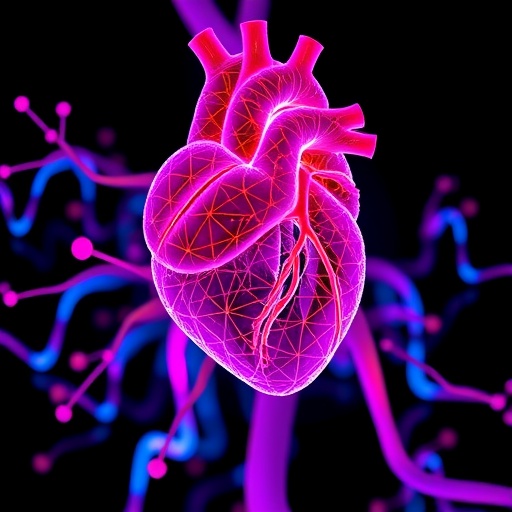In the evolving landscape of medical research, the multifunctional enzyme CD38 has recently taken center stage, revealing profound connections between cardiovascular and cerebrovascular health. This remarkable protein, previously studied primarily in the context of hematologic malignancies such as multiple myeloma, is now being recognized for its broader role in maintaining heart and brain function. Cutting-edge studies emphasize the immense therapeutic potential of CD38 inhibitors not only as anti-cancer agents but also as promising treatments for heart and brain diseases, catalyzing a paradigm shift in our approach to these complex conditions.
CD38 functions mainly as a multifunctional ectoenzyme, controlling the metabolism of nicotinamide adenine dinucleotide (NAD+), a critical coenzyme involved in cellular energy metabolism and signaling. In cancers like multiple myeloma, CD38 has been targeted effectively using monoclonal antibodies such as daratumumab and isatuximab, which block its activity, inhibiting tumor growth and promoting cell death. This clinical success has laid the foundation for expanding CD38-targeted therapies into the realms of cardiovascular and cerebrovascular care, where dysregulated NAD+ metabolism and inflammation are underlying factors.
Intriguingly, multiple myeloma patients often present with coexisting cardiovascular complications, including heart failure, arrhythmias, and thrombotic disorders, largely due to the systemic burden of the disease and factors like amyloidosis and renal dysfunction. These overlapping pathologies underscore the heart-brain interplay mediated by CD38. Research has demonstrated that targeting CD38 can alleviate cardiac dysfunction triggered by amyloid deposits, suggesting a dual benefit: combatting cancer progression while potentially preserving cardiac function.
Neurodegenerative and neuroinflammatory conditions also share pathological hallmarks linked to aberrant NAD+ metabolism and oxidative stress, where CD38’s role as a NADase enzyme becomes detrimental. This has sparked scientific interest in leveraging CD38 inhibitors to modulate brain inflammation and prevent neuronal loss. Early investigations reveal that compounds capable of inhibiting CD38 can suppress glial activation and reduce cytokine production, pathways crucial in neurodegenerative disease progression, suggesting a new frontier in neuroprotection.
Beyond antibodies, the search for effective CD38 inhibitors has expanded into several chemical classes, each with distinct mechanisms and therapeutic prospects. One such class is the NAD+ analogs, synthetic molecules designed to inhibit the NADase activity of CD38 directly, thus preserving intracellular NAD+ levels. Although still in preclinical stages with limited data on their cardiovascular and neurological effects, these analogs represent a promising avenue for modulating metabolic dysfunction in disease states.
Natural compounds have also emerged as potential CD38 inhibitors. Flavonoids—plant-derived antioxidants found abundantly in fruits and vegetables—exhibit notable inhibitory activity against CD38. Luteolin, apigenin, and quercetin have been shown to bolster myocardial and endothelial function by maintaining NAD+ availability, thereby protecting cardiac tissue against ischemia-reperfusion injury. Moreover, certain flavonoids dampen neuroinflammatory responses, providing a natural route to support brain health through CD38 modulation.
A groundbreaking breakthrough in this field is the identification of thiazoloquin(az)olin(on)e compounds, particularly one known as 78c. This novel chemical entity acts as a potent and selective inhibitor of CD38 and has demonstrated remarkable cardioprotective effects in preclinical experiments. Animal models subjected to ischemic heart injury exhibited significant improvement in myocardial contractility, decreased infarct size, and enhanced coronary perfusion following treatment with 78c, highlighting its therapeutic potential in acute cardiac events.
In the central nervous system, 78c has shown efficacy in mitigating saturation fat-induced neuroinflammation by raising NAD+ levels in astrocyte cultures. This highlights an intriguing link between metabolic stress, inflammation, and CD38 activity in the brain, positioning 78c and related compounds as candidates for novel treatments against neurodegenerative diseases involving chronic inflammation.
Despite these promising developments, the molecular mechanisms governing CD38’s dual role in cardiac and cerebral tissues require deeper elucidation. Future research endeavors aim to unravel its complex signaling networks and interactions with other cellular pathways, which may reveal new targets for intervention. Such insights will be crucial for designing inhibitors that maximize therapeutic benefits while minimizing adverse effects.
The integration of advanced technologies such as immunotherapy and gene editing offers exciting possibilities for enhancing CD38-targeted treatments. For instance, combining monoclonal antibodies with immune checkpoint inhibitors or CRISPR-mediated gene modulation could refine therapeutic efficacy and provide personalized approaches to treating cardiovascular and neurological diseases linked to CD38 dysregulation.
Moreover, the clinical translation of CD38 inhibitors from oncology to cardiology and neurology presents logistical and regulatory challenges. Rigorous clinical trials are needed to assess safety profiles, dosing regimens, and long-term outcomes in populations afflicted with heart and brain conditions. Collaborative efforts across disciplines will be essential to accelerate these investigations and validate CD38 inhibitors as versatile therapeutics.
The prospect of applying CD38-targeted therapies represents a holistic vision for medicine where interconnected systems—such as the heart and brain—are treated in an integrated manner. This approach not only addresses symptomatic manifestations but also targets fundamental molecular drivers of disease, raising hope for more effective interventions against some of the most debilitating illnesses worldwide.
In summary, CD38 stands at a promising intersection between oncology, cardiology, and neurology. The expanding repertoire of inhibitors—from monoclonal antibodies to small molecule compounds and natural products—provides a multifaceted toolkit for safeguarding heart and brain health. As research continues to unveil CD38’s diverse biological functions and therapeutic possibilities, it may revolutionize the way we confront cardiovascular and cerebrovascular diseases, offering renewed hope for millions of patients globally.
Subject of Research: The role of CD38 enzyme and its inhibitors in treating cardiovascular and cerebrovascular diseases, expanding from its established use in hematologic malignancies.
Article Title: CD38 connects the heart and brain.
Article References:
Tao, Y., Duan, J., Huang, K. et al. CD38 connects the heart and brain. Transl Psychiatry 15, 342 (2025). https://doi.org/10.1038/s41398-025-03597-9
Image Credits: AI Generated




